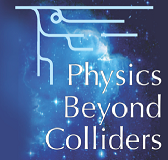Speaker
Description
The theory of strong interactions, Quantum Chromodynamics (QCD), predicts a rich variety of different phases of strongly interacting matter. The QCD phase diagram is usually represented as a function of the temperature and baryon density. At sufficiently high temperatures, a transition from hadronic matter to a Quark-Gluon Plasma (QGP), a state where quarks and gluons are no more confined into hadrons, is predicted.
Experimentally, the conditions for the formation of the QGP can be reached in collisions of heavy nuclei at ultra-relativistic energies. The exploration of the QCD phase diagram is up to now mainly restricted to the region of low baryon density. In this regime, lattice QCD calculations predict a cross-over transition between hadronic matter and QGP, occurring at a temperature of 155 MeV [1]. On the other hand, the phase diagram for moderate temperatures and high baryon densities is largely unknown and the existence of a first order phase transition with coexistence of a mixed-phase was suggested. The first order transition line should end with a second order critical point [2]. The experimental test of this scenario is one of the outstanding questions in the field of non-perturbative QCD.
Furthermore, in vacuum, the light hadron masses are largely due to the spontaneous breaking of QCD chiral symmetry. At the phase boundary between hadronic matter and the QGP, chiral symmetry should be restored. This implies a change in the hadron mass spectrum, but how this is realized is not known.
In order to shed light on these fundamental phenomena, we propose to define a new experimental apparatus (here denoted NA60+) to measure the production of muon pairs with unprecedented precision in fixed-target nucleus-nucleus collisions in a low-energy scan at the CERN SPS [3]. The CERN SPS is unique for such systematic investigations, because it can deliver high-intensity beams to study, e.g., Pb-Pb collisions over the energy range from $\sqrt{s_{NN}}=$5-6 up to 17 GeV in the centre-of-mass system.
In this energy regime, measurements of lepton pairs provide a rich set of observables. Dileptons are produced at all stages of the evolution of the created system, and offer the possibility to measure its temperature. The measurement for the first time of a caloric curve and the possible identification of a plateau can provide a direct and unambiguous evidence of a first-order phase phase transition. Chiral symmetry restoration can be also directly probed, by studying for the first time the mass modifications in a simultaneous measurement of the vector meson $\rho$ and its axial vector partner $a_1$ close to the onset of deconfinement.
In addition, the study of $J/\psi$ suppression and open-charm production are also expected to be sensitive to the onset of deconfinement.
High precision measurements of muon pairs were pioneered by the NA60 experiment, which coupled a traditional muon spectrometer to a silicon vertex tracker placed before the hadron absorber [4,5,6,7]. The NA60+ apparatus is meant as an evolution of NA60.
It aims at an increase in statistics by a factor $\sim100$ over NA60 and even larger over RHIC and LHC experiments, while retaining a very good signal-to-background ratio even in central Pb-Pb collisions [3].
The CERN SPS appears to be the best facility for these measurements.
Thanks to the new injection scheme it can deliver intense ion beams leading to interaction rates exceeding 1 MHz.
An ion beam could be delivered to a fixed target experiment while the SPS is used as injector for LHC.
Presently the NA61 experiment, with an experimental program on hadronic observables, is running at the CERN SPS and has a physics program complementary to the one proposed for NA60+.
In comparison, the other facilities operating in collider mode (RHIC and NICA) provide interaction rates 2-3 orders of magnitude smaller than the SPS, so that high-precision measurements are not possible. In addition, FAIR SIS/100 is designed to provide high interaction rates but the energy coverage is extremely limited. FAIR SIS/300 might provide a larger coverage but it is not approved at present and its operation would in any case only start well beyond 2030.
Thus, no presently approved experiment is able to cover such a large energy interval and to collect at the same time the large statistics required for truly quantitative measurements. A high precision dilepton experiment at the CERN SPS as NA60+ would then represent a unique opportunity to investigate the QCD phase diagram in the next decade.
[1] Bazavov et al., HotQCD Coll., Phys. Rev. D90 (2014) 9
[2] M.A. Stephanov, K. Rajagopal, E.V. Shuryak, Phys. Rev. D60 114028 (1999)
[3] A. Dainese, E. Scomparin, G. Usai et al., White paper INFN What Next: Ultra-relativistic Heavy-Ion Collisions - Frascati Physics Series, Volume LXII, ISBN 978-88-86409-85-8;
http://arxiv.org/abs/1602.04120
[4] R. Arnaldi et al., NA60 Coll., Phys. Rev. Lett. 96, 162302 (2006)
[5] R. Arnaldi et al., NA60 Coll., Phys. Rev. Lett. 99, 132302 (2007)
[6] R. Arnaldi et al., NA60 Coll., Phys. Rev. Lett. 100, 022302 (2008)
[7] R. Arnaldi et al., NA60 Coll., Eur. Phys. J. C 59 607 (2009)
